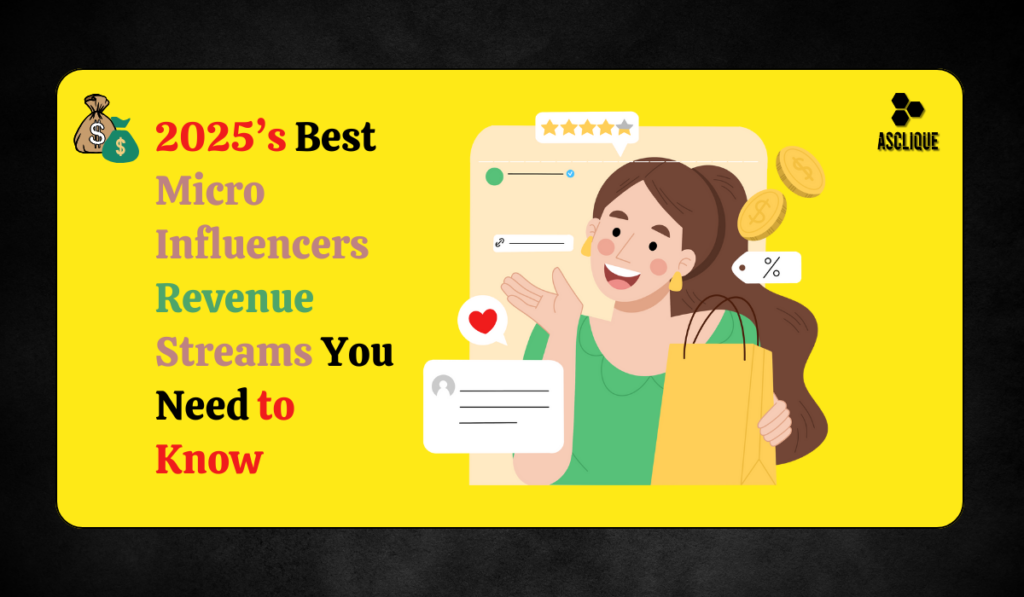Micro-influencers have gained incredible power and importance in the present-day digital marketing environment. Usually, micro-influencers have a following of 1,000 and 100,000. In their communities, they have built close relationships; as a result, their opinions and endorsements are trusted. Because of this, brands look toward micro-influencer partnerships to create authentic engagement and to reach selected audiences. Micro Influencers Revenue Streams offer a variety of opportunities for influencers to monetize their content, from sponsored posts to affiliate marketing and product collaborations. This article breaks down micro-influencers, brands working with them, the role of micro-influencer agencies, and the various ways through which they generate their revenues.
What Are Micro-Influencers?
Micro-influencers usually have less following but highly engaged than traditional celebrities or mega-influencers. They do belong into some particular niche and push the content that really resonates about audience. Because of such authenticity and connection, audience engagement is extremely high, hence, micro-influencers are considered a treasure for brands.

- Audience Size: Usually 1,000 to 100,000 followers.
- Niche Content: Micro-influencers are very often concerned about a particular area like beauty or fitness, or tech or travel and are able to build close-knit relationships with their audience.
- Genuine engagement: their content often feels relatable and personal in character which leads to higher levels of engagement when compared to the larger ones.
Influencers v/s Micro-Influencers
| Feature | Influencers | Micro-Influencers |
|---|---|---|
| Follower Count | 100K+ followers | 1K to 100K followers |
| Audience Reach | Larger, broader audience | Niche, targeted audience |
| Engagement Rate | Lower engagement (due to larger reach) | Higher engagement with followers |
| Authenticity | Often seen as less authentic due to their vast reach | Known for more personal, relatable connections with their audience |
| Brand Collaborations | Works with larger brands, often for big campaigns | Works with small to mid-sized brands or niche products |
| Content Type | General content catering to mass market | Focused content catering to specific niches (fashion, beauty, fitness, etc.) |
| Cost of Collaboration | Higher fees due to larger audience and influence | Lower fees, making them more accessible for smaller brands |
| Relationship with Followers | Often more distant, due to the sheer number of followers | Closer, more intimate relationship with their followers |
| Platform Popularity | Typically present on multiple platforms like Instagram, YouTube, etc. | Mostly active on one or two platforms, with a deep connection to their followers |
Notable Micro-Influencers Around The World
Jon Youshaei
- Jon has over 50K followers and shares insights on social media trends, content creation, and digital marketing This recognition is not just limited to his social audience, as major publications such as Forbes and NPR have taken note of his expertise in the field.
- Instagram: @jonyoushaei
- Country: USA
Aishwarya Taskar
- Aishwarya has around 30k followers. She focuses on beauty, fashion, and lifestyle content, engaging her audience with detailed product reviews and style tips.
- Instagram: @aishwarya_taskar
- Country: USA
Afroza Khan
- Afroza has a following of about 25K, she glams her diverse audience with style tips, beauty routines, and travel insights in the fashion and lifestyle realm.
- Instagram: @chicstylista
- Country: USA (Tampa & Miami)
Kevin Heimbach
- Over 100K followers, reviews, and an insider to theme parks and travel destinations for his followers, exposing them to popular attractions and experiences.
- Instagram: @kevinheimbach
- Country: USA
Zach Rana
- About 60K followers, he is a bodybuilder and fitness coach offering workout routines, fitness tips, and motivation toward healthy living.
- Instagram: @zachrana
- Country: USA
The niche audiences and real engagement active in these micro-influencers indicate that they can get quite a punch even when they don’t have the biggest follower counts. Their reach continues to expand because of their ties to the communities that support them.
Micro-Influencers Revenue Streams
There are various ways micro-influencers can monetize their influence and create multiple revenue streams. Here are the most common and profitable ones:
Sponsored posts and brand collaborations
- Micro-influencers are being paid by brands for promoting a product or service by means of either posts, stories, or videos. Such collaborations prove beneficial for brands in targeting an audience who trust the opinion of the influencer.
- Revenue: There can be variation depending on the engagement rates and audience size.
Affiliate Marketing
- Micro-influencers will earn a percentage of any sales made through their affiliate links for a product or service. So, this becomes an additional channel to earn passive income for influencers.
- Revenue: Percentage of sales made from clicking on the affiliate link.
Product Sponsorship and Free Products
- These brands send free products to micro-influencers for a review, unboxing, or other content creation purposes. It may not generate money directly, but they give exposure to the product and the future possibilities of collaboration.
- Revenue: Products, services, or free merchandise.
Brand Content Creation
- Micro-influencers are often hired to create high-quality content to the brands’ philosophies and later share it with the brand on their social media sites, website, or advertising campaigns.
- Revenue: Payment for content creation, usually defined high or low, in line with the influencer and quality of content.
Paid Social Media Campaigns
- Micro-influencers get paid to participate in paid social media campaigns that involve some co-branding or agency collaboration in designing promotional communication for a specific service or product. The paid campaigns are also featuring different influencers and over multiple platforms.
- Revenue: Paid as per campaign or post.
Co-Product Development
- As micro-influencers build their personal brands, they often get opportunities to partner in building products with brands and/or collaborations on limited-edition merchandise, thus sharing revenue on sales.
- Revenue: Share from product sales or limited-edition collaborations.
Webinars and Workshops
- Niche specialists could charge for paid access to their webinars, workshops, or coaching sessions. In so doing, they can monetize their information proposition while giving the audience some insights into it.
- Revenue: Payments from attendees or subscribers.
Personal Merchandising
- Selling personal merchandise generates one of the very profitable Micro Influencers Revenue Streams. Clothing, accessories, digital products, or art, these micro-influencers can carve out a niche for his or her merchandise: create and sell to their audience. And it would not only give them direct income, but also work toward enhancing their brand identity.
- Revenue: Full profit from the sale of merchandise minus its production cost.
Crowdfunding and Donations
- Through sites such as Patreon and Ko-fi, micro-influencers receive ongoing support from their followers through donations or subscriptions, creating a steady income stream.
- Revenue: Monthly donation and subscription income.
Micro-Influencers Revenue Streams: Maximizing Earning Potential
To optimize their earning potential, micro-influencers often diversify their revenue streams. By tapping into multiple monetization avenues, they can build a sustainable and profitable career. Whether it’s engaging in affiliate marketing, creating high-quality content for brands, or launching their own merchandise, the opportunities are vast. The more revenue streams micro-influencers explore, the more diversified and secure their income can become.
Every revenue stream for micro-influencers presents them with various opportunities, and those that really excel at it will find ways to balance and maximize them for their long-term sustainability. They create engaging content that keeps their audiences committed. They form partnerships with brands and platforms whose missions align well with theirs strategically. With these factors mixed together, micro-influencers stand to earn a lot from doing what they truly love.
Brands That Work with Micro-Influencers
Brands across various industries are recognizing the power of micro-influencers to reach niche markets and build authentic connections with their audiences. Here are some key sectors that frequently partner with micro-influencers:
Beauty Brands
Example: Glossier, Fenty Beauty
Micro-influencers in the beauty space perform tutorials, product reviews, and skin routines, helping brands easily build trust and visibility in a competitive market.
Fashion Brands
Example: ASOS, Revolve
Micro-influencers in fashion present clothing, accessories, and styling tips in a relatable, realistic way for fashion inspiration for their audience.
Fitness and Wellness
Example: Gymshark, Nike
Micro-influencers in fitness promote workout routines, apparel, and wellness products that inspire followers to engage with personal content and fitness tips.
Food and Beverage
Example: HelloFresh, Blue Apron
Micro-influencers in food and beverages share recipes, cooking tips, and product reviews, allowing for a more relatable and authentic creation of culinary content.
Tech and Gadget
Example: Apple, Samsung
Micro-influencers in technology review gadgets, apps, and software, giving brands access to an earnest and involved group of tech-craving audience.
Micro-Influencer Agencies
The rise of so-called micro-influencers has made agencies highly essential for managing influencer partnerships. Micro-influencer agencies act as intermediaries, connecting brands with influencers, running the campaign, and making sure that the right influencer gets to match up with the appropriate brand.
- Role: Micro-influencer agencies help brands identify influencers that align with the target audience, and manage logistics concerning the influencer collaborations.
- Services Provided: Campaign management, influencer outreach, contract negotiation, content creation, and performance tracking.
Some examples of micro-influencer agencies include:
- Influence.co
- The Influencer Agency
- Takeoff Creative
These agencies streamline the process, making it easier for brands to execute influencer campaigns while allowing micro-influencers to focus on content creation and audience engagement.
Conclusion
Micro-influencers form a significant facet of the whole digital marketing scenario, deigning many monetization options through their revenue streams. These micro-influencers can earn money through various sources that include paid posts or affiliate marketing. Revenue streams with micro-influencers allow them to increase their revenue without compromising the interests of their niche audience.
Micro-influencers gain more significance for brands to tapping into their highly engaged and loyal following, while their work is made easier by agencies. With an ever-increasing emphasis on relatively authentic and targeted marketing against their larger counterparts, the micro-influencers will also have an unparalleled input in shaping the future of digital marketing-and beyond-content creation.
By allowing micro-influencers to diversify their revenue streams, they will remain well in this fast-changing industry, thereby putting themselves in a position to maximize their influence and engagement.
FAQs
What distinguishes the micro-influencers from macro-influencers?
Micro-influencers: 1000 to 100000 followers, engaging well; macro-influencers: have considerably larger followings and lower engagements in comparison.
How does a micro-influencer make money?
Micro-influencers make money through sponsored posts, affiliate marketing, merchandise sales, webinars, and donations.
What kind of brands usually work with micro-influencers?
Beauty, fashion, fitness, tech, and food brands often employ micro-influencers for marketing targeted campaigns.
How much does a micro-influencer earn?
The amount depends on the engagement, niche, and type of revenue stream, so it can go anywhere from $50 to $5,000 per post.
Will the micro-influencer use an agency to manage advantages of partnerships?
No, but a micro-influencer agency can help with campaign management, book brand deals, and performance tracking benefits.

